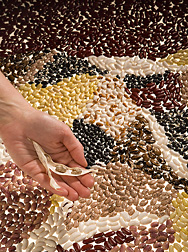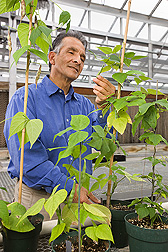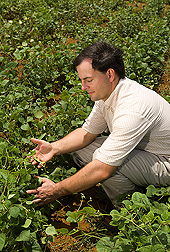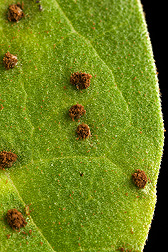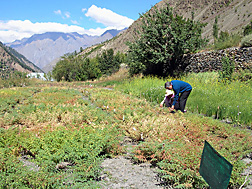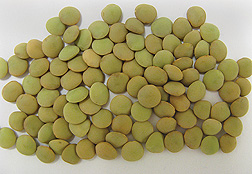Help for the Common Bean:
Genetic Solutions for Legume Problems
The common bean—which includes pinto, great northern, navy, black, kidney, and snap beans—is considered by many nutritionists to be a nearly perfect food because of its high protein content and low cost. But it is also susceptible to many diseases that reduce seed and pod quality and yields. Agricultural Research Service scientists from labs across the United States are playing major roles in finding solutions to what ails these legumes.
Beltsville Beans Key to Combating Devastating Rust Pathogen
ARS plant pathologist Talo Pastor-Corrales, throughout his career, has traveled to 21 countries in the Americas and 11 in Africa studying bean diseases and searching for bean varieties that contain special traits—particularly disease resistance—that could be used to improve common beans. In the Soybean Genomics and Improvement Research Unit in Beltsville, Maryland, Pastor-Corrales specializes in genetic resistance of the common bean (Phaseolus vulgaris) to various diseases.
He’s also the lead scientist in a project that aims to discover and breed genes into P. vulgaris for resistance to common bean rust and the newly arrived Asian soybean rust pathogen, which also infects the common bean.
|
|
The fungus that causes bean rust is very aggressive and exists as many different strains called “races.” Pastor-Corrales says, “When new races appear, they can infect bean varieties that were previously resistant to rust.” Further complicating matters is the fact that races present in a field can vary from one year to another.
Of major concern is the loss of effectiveness of the Ur-3 rust-resistance gene in beans, which has been very effective in controlling bean rust in the United States, especially in North Dakota and Michigan, the two largest producers of dry beans in the United States. In recent years, however, rust has developed on these once-rust-resistant bean varieties, and there is concern that the new races will spread to other Northern Plains states, such as Colorado and Nebraska.
In 2008 and 2009, Pastor-Corrales and his project team were credited with developing new dry bean cultivars resistant to the rust pathogen. Pastor-Corrales collaborated with scientists from the University of Nebraska and Colorado State University. The new cultivars contain two or more rust-resistance genes and most also have the Ur-11 gene, considered the most effective rust-resistance gene in the world.
|
|
Beans That Can Take the Heat
At test plots in southern Puerto Rico, ARS plant geneticist Tim Porch’s beans are feeling the heat. As part of collaborative breeding efforts with Cornell University, the University of Nebraska, and the University of Puerto Rico, Porch and colleagues have been testing new bean germplasm for heat and drought tolerance and disease resistance. So far, their efforts have proved fruitful.
Porch is in the process of releasing two new kidney bean varieties with heat tolerance. These germplasm releases, named “TARS HT-1” and “TARS HT-2,” were initiated by ARS plant geneticist Rusty Smith, now with the ARS laboratory in Stoneville, Mississippi. TARS HT-1 does well under the stress of high day and high night temperatures, whereas TARS HT-2 does well under the stress of high day and moderate night temperatures.
Also in the works is new black bean germplasm with heat and drought tolerance and resistance to common bacterial blight, a seedborne disease—spread by splashed water—that mainly attacks the plant’s leaves and pods. Porch crossed tropical black and red beans to produce these germplasm lines, which are adapted to temperate areas and will help to increase the diversity of U.S. bean germplasm. Field tests in Nebraska show that the lines yield well in addition to having tolerance to heat, drought, and disease.
|
|
“The beans we are testing have broad adaptation,” says Porch, who is with ARS’s Tropical Agriculture Research Station (TARS) in Mayagüez, Puerto Rico. “Our lines do well in the short days common to Puerto Rico and the long days found in Nebraska.” Porch is testing other bean types—red, pinto, great northern, and navy—that are drought tolerant, and some also have heat tolerance and disease resistance. “My goal is to pyramid multiple resistances to generate lines with broad adaptation and genetic diversity.”
Porch is also involved in bean-improvement efforts in Angola, a country that is beginning to recover from many years of civil war. The project, funded by USAID and led by the University of Puerto Rico, supports Angola’s common bean breeding program. Porch and university colleagues conduct breeding and pathology training sessions, host Angolan scientists to train them in the laboratory, and help the scientists breed for traits of importance, such as resistance to angular leaf spot, common bacterial blight, and bean common mosaic virus.
|
|
Washington’s Wonders
At ARS’s Vegetable and Forage Crops Research Laboratory in Prosser, Washington, plant pathologist Richard Larsen and geneticist Phil Miklas recently identified new sources of resistance for protecting snap beans from the viral disease chocolate pod, which was first detected in Wisconsin, Michigan, and other Great Lakes states in 2001 and inflicts unsightly defects on pods, ruining their marketability.
Insecticides are sometimes used to kill virus-transmitting aphids. But incorporating resistance into snap beans is considered a more sustainable approach. Toward that end, the researchers devised DNA marker technology to help speed identification and use of plants harboring chocolate pod resistance without having to grow them to maturity.
Reducing insecticide use—and safeguarding the environment—was also the goal of a project that entomologist Stephen Clement recently completed at ARS’s Plant Germplasm Introduction and Testing Research Unit in Pullman, Washington. There, as part of a 3-year project supported by the U.S. Agency for International Development, Clement led development of chickpea germplasm lines offering beet armyworm resistance. The moth’s caterpillar stage attacks many crops, but is especially problematic in chickpeas in India, which produced 6.6 billion tons of the high-fiber, vitamin-rich crop in 2005.
|
|
Clement collaborated on the project with scientists at Washington State University-Pullman and the International Crops Research Institute for the Semi-Arid Tropics (ICRISAT) in Patancheru, India. In U.S. trials, 28 to 62 percent of beet armyworms that fed on the leaves of resistant chickpeas died within a few days. Those that survived were smaller and shorter than usual. Now, ICRISAT entomologist Hari Sharma is conducting field trials to evaluate the resistant chickpeas’ potential to forestall insecticide use.
Earlier this year, George Vandemark, a geneticist at ARS’s Grain Legume Genetics and Physiology Research Unit, also in Pullman, released a new Eston class lentil named “Essex.” This new variety was developed through a collaborative effort involving Vandemark, Fred Muehlbauer (now retired from ARS), and North Dakota State University pulse crop breeder Kevin McPhee.
|
|
They chose Essex for release because of its outstanding performance in yield trials conducted in Washington State, Idaho, North Dakota, and Montana—states that produced a combined $87 million’s worth of lentils, most of it for export.
On average, Essex yielded 1,220 pounds of seed per acre—21 percent more than Eston and 22 percent more than Athena, commercial varieties used for comparison. Essex is intended for production in the Northern Plains, with Mexico and other Latin American nations as prime export destinations.—By Alfredo Flores, Stephanie Yao, and Jan Suszkiw, Agricultural Research Service Information Staff.
This research is part of Plant Genetic Resources, Genomics, and Genetic Improvement (#301) and Plant Diseases (#303), two ARS national programs described at www.nps.ars.usda.gov.
To reach the scientists mentioned in this article, contact Alfredo Flores, USDA-ARS Information Staff, 5601 Sunnyside Ave., Beltsville, MD 20705-5129; (301) 504-1627.
Better Beans Mean Better Health for People Everywhere
Whether it’s a side of beans for a hearty breakfast, an extra-spicy chili at lunch, or an elegant, chilled black bean soup at dinner, beans can add pleasing color and texture to any meal. And, importantly, beans provide iron, an essential nutrient needed in comparatively small, or “micro,” amounts.
In Ithaca, New York, ARS physiologist Raymond P. Glahn, ARS research associate Elad Tako, Cornell University analytical chemist Michael A. Rutzke, and others conduct research that may help plant breeders develop new and improved beans that are even better sources of iron. Their research would especially benefit the more-than-2-billion people around the globe who are deficient in iron. Iron deficiency is, in fact, the world’s number-one micronutrient deficiency.
Some of these investigations are designed to determine how to boost beans’ iron bioavailability—the amount of iron our bodies can absorb and use from beans. That might be done in a number of ways, all using plant breeding. One way, of course, would be to increase the level of iron in these legumes. Another approach would be to increase the effects of certain natural compounds that enhance iron bioavailability. A third tactic: decrease the effects of natural compounds that make iron less absorbable.
To discover more about the availability of iron in beans—or in other foods and food components—Glahn developed a laboratory test in 1998 that uses Caco-2 (pronounced KAY-coe) human intestinal cells to give an indication of how our digestive system would treat beans and nutrients from beans.
Glahn says follow-up tests with lab animals “are an important intermediate step between the Caco-2 tests and costly studies with human volunteers.” In recent years, Glahn and coresearchers at the ARS Robert W. Holley Center for Agriculture and Health, on the Cornell University campus at Ithaca, have shown that chickens “have promise as an animal model for iron absorption studies.”
In research published this year in the journal Poultry Science, the scientists report that chickens are sensitive to iron deficiency and that at least a half-dozen different indicators of this deficiency, used in studies with other animals, are also valid for research with chickens.
The team’s tests with chickens confirmed their Caco-2 findings, namely, that iron in red beans was less bioavailable to the animals than iron in white beans.
Notes Glahn, “This is the first time this disparity in bean-iron bioavailability has been shown in an animal study. It has implications for human nutrition.”
The investigation underscores the contribution that findings from Caco-2 and poultry-based assays might have in helping reverse iron deficiency worldwide.—By Marcia Wood, Agricultural Research Service Information Staff.
"Help for the Common Bean: Genetic Solutions for Legume Problems" was published in the May/June 2010 issue of Agricultural Research magazine.







